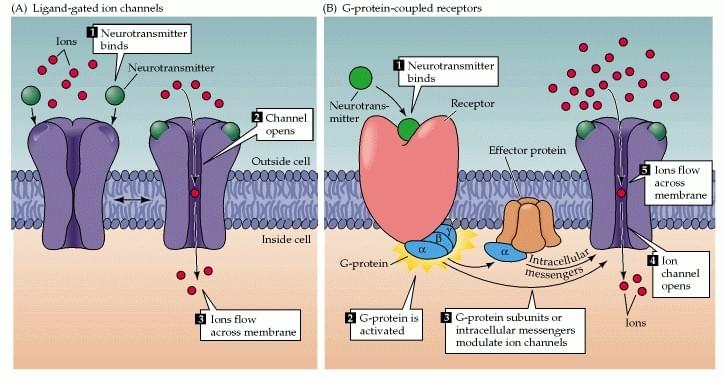Custom MemPro™ Pentameric Ligand-gated Ion Channels Services
Creative Biostructure provides custom gene-to-structure services for pentameric ligand-gated ion channels.
Pentameric ligand-gated ion channels (pLGICs) are essential transmembrane receptors for neurotransmission at chemical synapses and other cell-cell signaling in the central and peripheral nervous system. The family shares a pentameric organization of identical subunits that consist of an extracellular ligand-binding domain followed by a transmembrane channel domain. Ligands binding directly cause a drastic conformation change that result in opening or closing the channel.
 Figure. A comparison between ligand-gated ion channels and GPCRs
Figure. A comparison between ligand-gated ion channels and GPCRs
Depending on their locations, pLGICs can be divided into two types: cationic channels (acetylcholine — nAChR — and 5HT3 receptors) and anionic ones (glycine and GABA receptors).
Nicotinic acetylcholine (ACh) receptors are responsible for transmission of nerve impulses from motor nerves to muscle fibres (muscle types) and for synaptic transmission in autonomic ganglia. When a pulse of ACh is released at the nerve-muscle synapse, the channels in the postsynaptic membrane of the muscle cell open, and the initial electrochemical driving force is mainly for Na+ to pass from the extracellular space into the interior of the cell. They are also present in the brain where they are presumed to be responsible for nicotine addiction. For nAChR which located in different tissues, they share quite different subunits to encircle a different ring. 5-HT3 is therefore different with other 5-HT receptors (serotonin) whose action are mediated by G protiens. 5-HT3A and 5-HT3B are two well-studied subtype 5-HT receptors and their subunits form homomeric receptors and heteropentamers, respectively. 5-HT3 receptors are located in both the peripheral (PNS) and central (CNS) nervous systems. 5-HT3 receptors are involved in information transfer in the gastrointestinal tract, and in the enteric nervous system they regulate gut motility and peristalsis. They also play an important role in the urinary tract, and indeed expression of hypersensitive.
GABA is one of the most important inhibitory neurotransmitter in the mammalian Central nervous system. GABA associated channels are permeable to Cl-; the flow of the negatively charged chloride ions inhibits postsynaptic cells. The receptors for glycine are also ligand-gated Cl- channels, their general structure mirroring that of the GABAA receptors. There are a lot of drugs targeting GABA receptors and there is a specific site called benzodiazepine binding site lies outside the pore and modulates channel activity. Benzodiazepines, such as diazepam enhance GABAergic transmission and promote anesthesia and control epilepsy.
References:
Sauguet L, Shahsavar A, Poitevin F, et al. Crystal structures of a pentameric ligand-gated ion channel provide a mechanism for activation[J]. Proceedings of the National Academy of Sciences, 2014, 111(3): 966-971.
Bowery N G, Smart T G. GABA and glycine as neurotransmitters: a brief history[J]. British journal of pharmacology, 2006, 147(S1): S109-S119.
Costall B, Naylor R J. 5-HT3 receptors[J]. Current Drug Targets-CNS & Neurological Disorders, 2004, 3(1): 27-37.